INSTRUCTIONS TO CANDIDATES
- Answer all the questions
- Mathematical table and silent electronic calculators may be used.
- All working must be clearly shown where necessary.
QUESTIONS
- Three pure pigments were prepared and their spots placed on a filter paper as shown below. The three pigments are A, B and C. A mixture F was also placed on the filter paper at the same time with the pure pigments. The filter paper was then dipped in ethanol solvent and left for some half an hour. The results were obtained as follows.

- Which of the three pure pigments is most sticky? Give a reason for your answer. (1mk)
- Which pure pigment is not present in the mixture F? (1mk)
- Show on the diagram the baseline. (1mk)
- Describe how a pure sample of lead (II) carbonate can be prepared in the laboratory starting with lead II oxide.(3mks)
- The set-up below was used to prepare nitric (v) acid in the laboratory
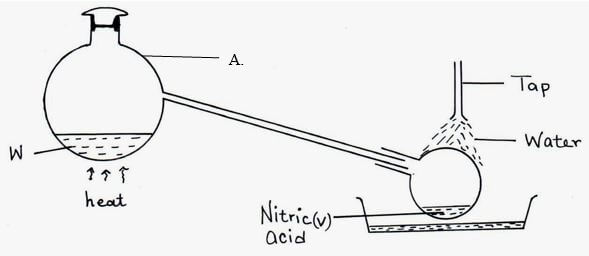
- Name the mixture W (1 mk)
- Write an equation for the reaction that takes plac ein Flask A (1 mk)
- Explain why conc. nitric (v) acid produced appears yellow when exposed to sunlight. (1mk)
- A mixture contains ammonium chloride, aluminium oxide and sodium chloride. Describe how each solid substance can be obtained from the mixture. (3mks)
- State the difference between the following salts;
Deliquescent and hygroscopic salts. (2mks) - Below is a set-up of apparatus used to investigate the effect of electric current on molten lead (II) bromide.

- Name electrode. (1mk)
K
L - State the observation made at electrode K. (1mk)
- Write an equation for the reaction taking place at electrode L. (1mk)
- Name electrode. (1mk)
- A sample of a polyethene polymer has the following structure.

- Draw the structural formula of the monomer that makes the above polymer
- The polymer is found to have a molecular mass of 2268g. Determine the number of monomers in the polymer.
(H = 1, C = 12). (2mks)
- The isotopes hydrogen are 11H and 21H. Determine the molecular masses of the molecules formed when each of these isotopes react with chlorine. (Cl = 37, H=1) (1mk)
- The table below gives the atomic numbers of elements W,X,Y and Z. The letters do not represent the actual symbol of the elements
Element A B C D Atomic Number 9 10 11 12 - Which one of the elements is unreactive? Explain (1mk)
-
- Which two elements would react most vigorously with each other? (1mk)
- Give the formula of the compound formed when the elements in b (i) above react (1mk)
-
- Distinguish between a hydrogen bond and covalent bond (2mks)
- Explain why the boiling point of water is higher than that of hydrogen Sulphide
(Relative molecular mass of water is 18 while that hydrogen sulphide is 34) (2mks)
- The set-up below was used to investigate the products of burning methane gas. Study it and answer the questions that follow:
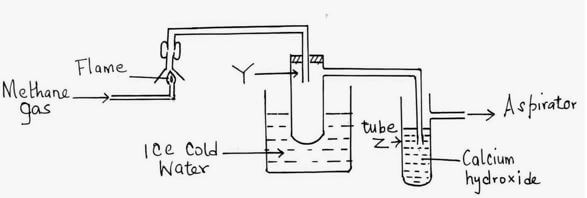
- What product will be formed in the test tube Y? (1mk)
- State and explain the observations made in tube Z. (2mks)
- Below are PH values of some solutions.
Solution Z Y X W pH 6.5 13.5 2.2 7.2 - Which solution is likely to be:
- Acidic rain. (½mk)
- Potassium hydroxide (½mk)
- A basic substance V reacted with both solutions Y and X. What is the nature of V. (1mk)
- Which solution is likely to be:
- In cold countries, salt is sprayed on the road to melt ice but in the long run it costs the motorists.
- How does the salt help in melting ice? (1mk)
- How does the salt affect the motorists? (1mk)
- Using dots (. ) and crosses (x) to represent electrons, show bonding in the compounds formed when the following elements react: (Si=14, Na=11, Cl=17):
- Sodium and chlorine. (2 Mks)
- Silicon and chlorine. (2 Mks)
-
- State Graham’s law of diffusion. (1mk)
- 20cm³ of an unknown gas Q takes 12.6 seconds to pass through a small orifice, 10cm³ of oxygen gas takes 11.2 seconds to diffuse through the same orifice under the same conditions of temperatures and pressure. Calculate the molecular mass of unknown gas Q (O = 16). (3mks)
- The peaks below show the mass spectrum of element X.
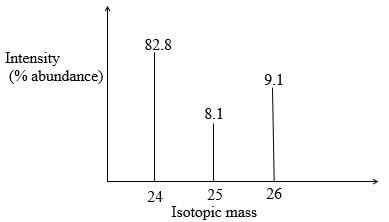
Calculate the relative atomic mass of X. (2mks) - Name the following compounds using the IUPAC rules.
- CH3CH2CHCH2CH2CH3
|
CH2CH3 (1mk) - CH3CHCHCH3 (1mk)
- Draw TWO structural formulae of isomers of compound with the molecular formula CH3CH2CH2CH3 (2mks)
- CH3CH2CHCH2CH2CH3
-
- What is meant by allotropy? (1 mk)
- The diagram below shows the structure of one allotropes of carbon.

- Identify the allotrope ( 1 mk)
- State one property of the above allotrope and explain how it is related to its structure (2mk)
- 24cm³ of a solution of 0.1 M potassium hydroxide were exactly neutralized by 30cm³ of a solution of sulphuric acid. Find the molarity of the acid. (3 mks)
-
- Give one use of hygroscopic substances in the laboratory. (1 mk)
- What is meant by the terms: (2 mks)
- Isotopes
- Mass number
- The formulae for a chloride of phosphorus is PCl3. What is the formula of its sulphide? (1 mk)
- The diagram below shows the Frasch process used for extraction of sulphur. Use it to answer the questions that follow.

- Identify X. (1mk)
- Why is it necessary to use super heated water in this process? (1mk)
- State two physical properties of sulphur that makes it possible for it to be extracted by this method (1mk)
- A certain carbonate XCO3 , reacts with dilute hydrochloric acid according to the equation given below:
XCO3(s) +2HCl (aq) → XCl2 (aq) + CO2 (g) + H2O (l)
If 4g of the carbonate reacts completely with 40cm3 of 2M hydrochloric acid, calculate the relative atomic mass of X.
(C=12.0 ,O=16.0, Cl=35.5). (3 Mks) - The table below gives some properties of three substances I, J and K. Study it and answer the questions that follow.
Substance Mpt (ºC) Solubility in water electrical conductivity solid molten I 1063 Insoluble conduct conduct J 113 Insoluble Doesn't Doesn't K 402 Sparingly soluble Doesn't conduct and is decomposed - Suggest the type of structure in:
- I (1mk)
- K (1mk)
Explain why the molten K is decomposed by electric current but I is not decomposed.(2mks)
- Suggest the type of structure in:
- Concentrated sulphuric acid is slowly added to a mixture of freshly prepared solution of iron (II) sulphate and potassium nitrate as below.

- State the observation (1mk)
- Study the inforation given in the table below and answer the questions that follow.
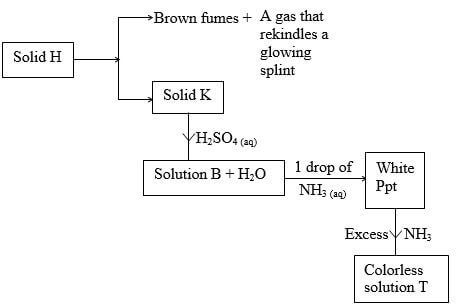
- predict the cation and anion present, in solid H
- Cation (1mk)
- Anion (1mk)
- Identify:
- solution K (1mk)
- solution B (1mk)
- White precipitate (1mk)
- predict the cation and anion present, in solid H
Marking scheme
-
- A – moves shortest distance
- B
-
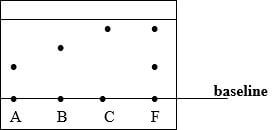
-
- Measure a fixed volume of nitric V acid in a beaker
- Add lead II oxide to the acid until in excess
- Filter the mixture and collect the filtrate lead II nitrate
- To the filtrate add a solution of sodium carbonate solution to precipitate lead carbonate
- Filter the mixture and collect the residue lead II carbonate wash the residue and dry it under low temperature or btw filter papers
-
- Conc. sulphuric (VI) acid + potassium nitrate
- H2SO4(l) + KNO3(S) → KHSO4(aq) + HNO3(aq)
- Nitric (V) acid decomposes on exposure to light to form nitrogen (IV) oxide.
-
- Heat the mixture ammonium chloride sublimes and is collected on the cooler part of boiling tube./accept a diagram
- Add water to dissolve NaCl.
- Filter to obtain Al2O3 as a residue.
- Evaporate the filtrate to obtain NaCl
-
- Deliquescent – Absorbs water from atmosphere to form a solution.
- Hygroscopic – Absorbs water from the atmosphere and do not form solution.
-
-
- K Anode
- L Cathode
- Red-brown vapour
- Pb2+(l) + 2ë → Pb(s)
-
-
-

- 2268/28 = 81 monomers
-
-
Molecule: HCl
MM. of 11 HCl = 38
Of 21 HCl = 39 -
- B. Has completly filled outer energy level
-
- A and C
- CA //NaF reject AC
-
- hydrogen bond is formed between a hydrogen atom of one molecule with a more electronegative/an oxygen of another element of another molecule.
accept illustration e.g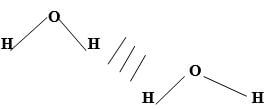
Covalent bond is formed when two electronegative elements bond by each donating an electron to be shared in the bond. - (Relative molecular mass of water is 18 while that hydrogen sulphide is 34)
Water has hydrogen bonding in addition to vanderwaals forces which makes the intermolecular force strong requiring more energy, while hydrogen sulphide has only weak vander waals forces which requires less energy to break.
- hydrogen bond is formed between a hydrogen atom of one molecule with a more electronegative/an oxygen of another element of another molecule.
-
- Water/H2O
- A white precipitate. ✔½ Burning methane produces carbon (IV) oxide ✔½
Which reacts with calcium hydroxide to form the insoluble ✔½ calcium carbonate ✔½
-
-
- Z
- Y
- Amphoteric
-
-
- Salt acts as an impurity. Lowers Mpt of ice hence ice melts at low Mpt.
- Salt increases rate of rusting of the metallic parts of the vehicles.
-
- Sodium and chlorine.

- Silicon and chlorine.
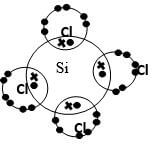
- Sodium and chlorine.
-
- Graham's law of diffusion: Under the same conditions of temperature and pressure, the rate of diffusion of a gas is inversely proportion to the square root of its density.
-
TO1/ TO2 = √MO1/MO2
Where TO1 = 12.6 sec.
TO2 = 22.4 sec.
MO2 = 2 × 16 = 32
12.6/22.4 = √MO1/32
RQ1 = RMM of Q2
RQ2 = RMM of Q1
MO~ = (12.6/22.4)2 × 32
= 10.13 M
- Atomic mass of X
(24 × 82.8) + (25 × 81) + (26 × 9.1)
100
= 1987.2 + 202.5 + 236
100
=2426.3
100
=24.263 -
- 3-ethyl hexane
- But-2-ene
-
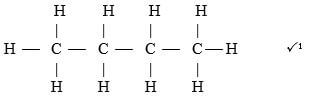

-
- Allotropy is the existence of an element in more than one form without change in physical state
-
- graphite.
-
- It is a lubricant because layers slide over each other
- a good conductor of both heat and electricity because it has delocalised/mobile electrons
- 2KOH(aq) + H2SO4(aq) → K2SO4(aq) + 2H2O ✔½
0.0024 0.0012
Moles of KOH(aq) =24 × 0.1 = 0.0024 ✔½
1000
Moles of H2SO4(aq) = ½ × (0.0024) = 0.0012 ✔½
Molarity of H2SO4 = 0.0012 × 1000
30
= 0.04M ✔½ -
- used as drying agents for wet gases/test presence of water
-
- Isotopes are atoms with same number of protons/atomic numbers but different number of neutrons/mass numbers
- Mass number is the total number of number of protons and neutrons in an atom.
- P2S3
-
- Hot compressed air.
- To melt sulphur
-
- Low melting point
- Does not dissolve in water
- No. Of moles of HCl in 40cm3 of 2M HCl
= 40cm3 × 2M
1000
=0.08moles
Mass of HCl in 0.08moles = 36.5 × 0.08
= 2.92g
4g of the XCO3 reacts with 2.92g 0f HCl.
X + 60g of XCO3 reacts 2 x 36.5g of HCl
2.92 ( X + 60 )g = 4 × 2 × 36.5g
2.92X + 175.2 = 292
2.92X = 292 - 175.2
=116.8
X= 116.8/2.92
=40 -
-
- I Giant metallic ✔½ Reject metallic
- K Giant ionic ✔½ Reject ionic
- K is an ionic compound while I is a a metallic element with mobile electrons
-
-
- A brown ring
-
-
- Cation Zn2+
- Anion No-3
-
- solution K -ZnO
- solution B ZnSO4
- White precipitate Zn(OH)2(s)
-
Join our whatsapp group for latest updates
Tap Here to Download for 50/-
Get on WhatsApp for 50/-
Download Chemistry Paper 1 Form 3 Questions and Answers - Term 3 Opener Exams 2021.
Tap Here to Download for 50/-
Get on WhatsApp for 50/-
Why download?
- ✔ To read offline at any time.
- ✔ To Print at your convenience
- ✔ Share Easily with Friends / Students

